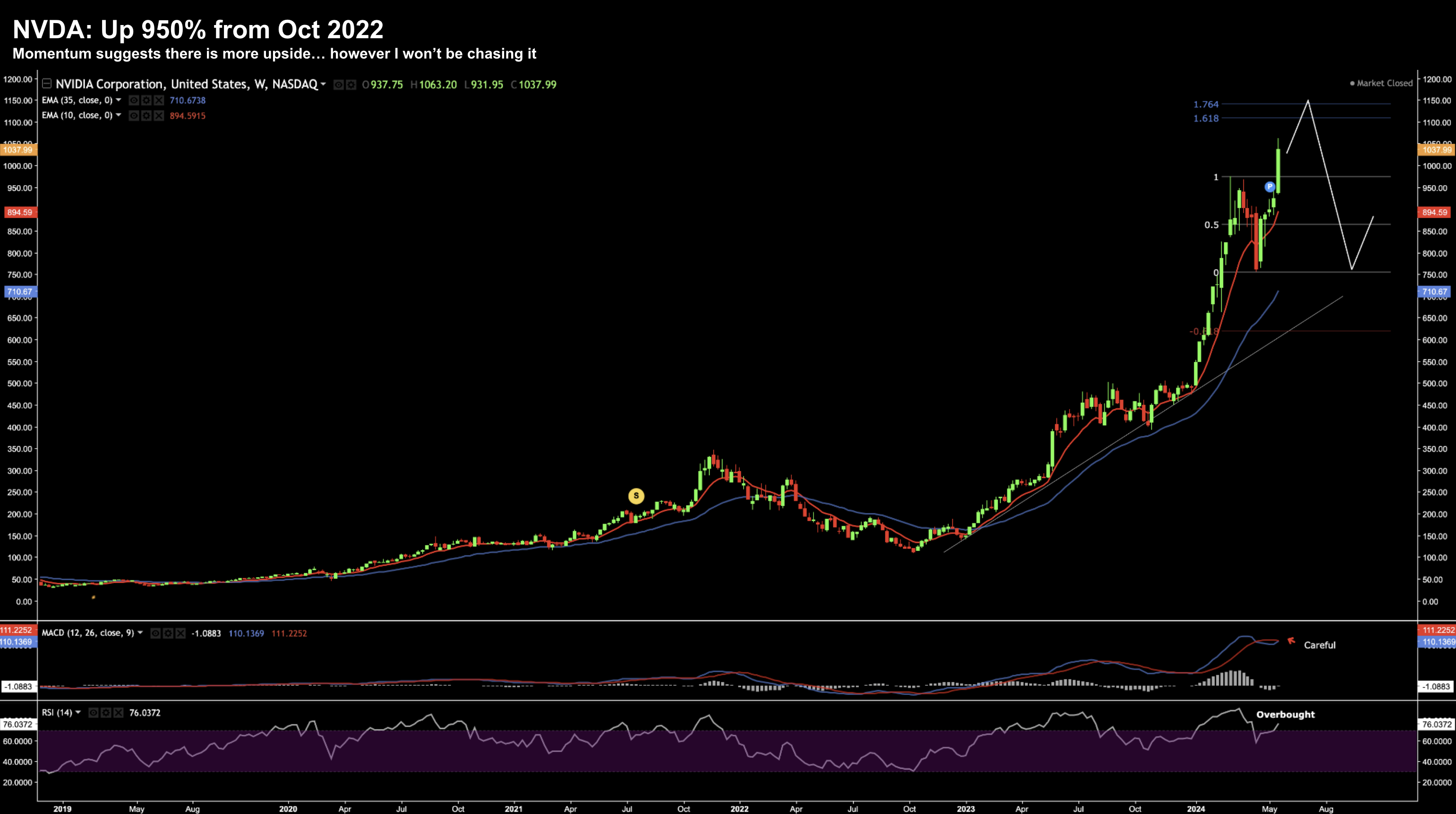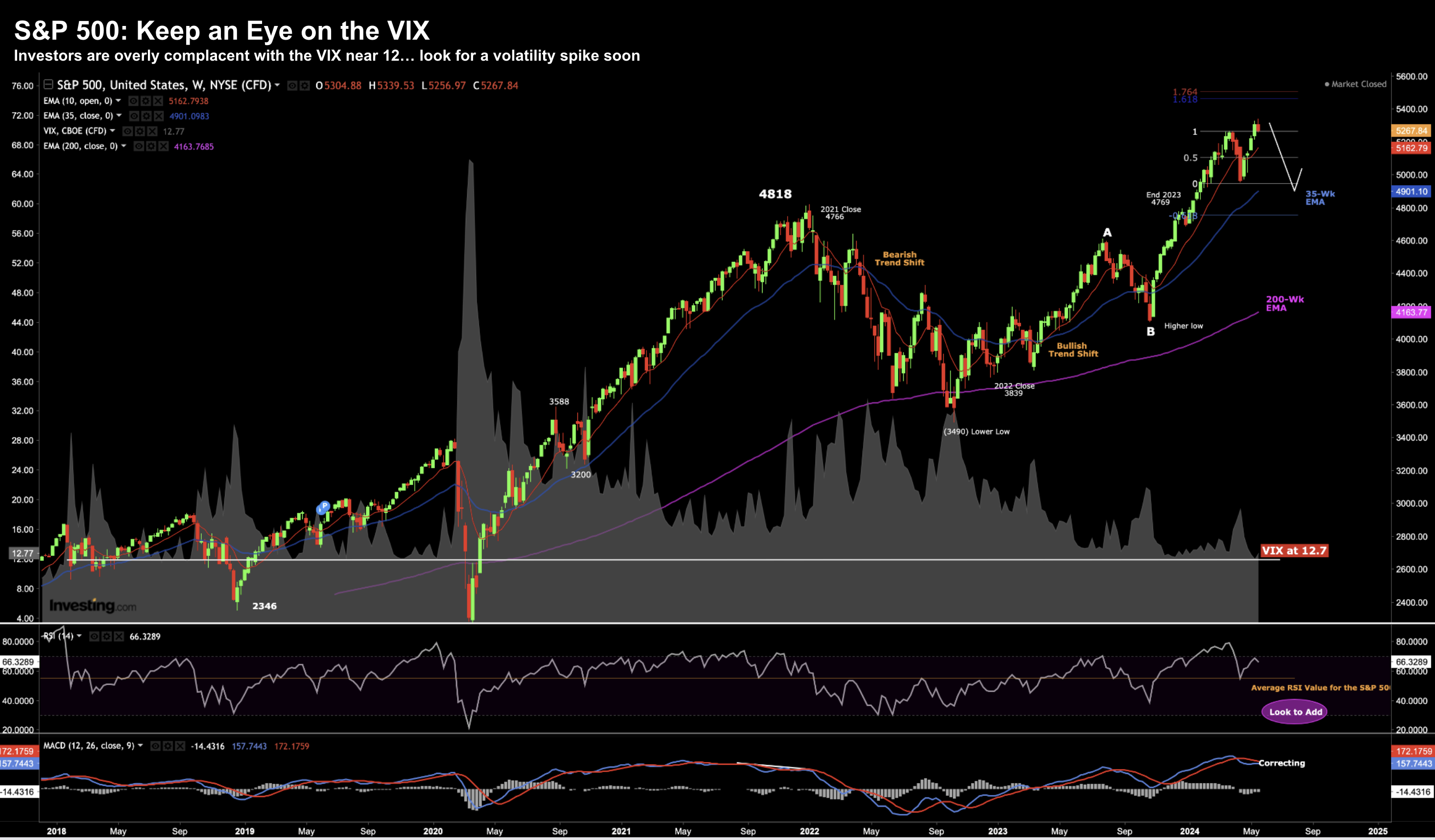- Nvidia continues to remind me of Cisco ~25 years ago
- Market feels overly complacent opposite the risks
- PMI suggests “higher for longer” rates – as inflation moves higher
Let’s start repeating a few words from my post May 11th:
We may want to pencil in the date of May 22nd…. the day of Nvidia’s (NVDA) earnings. For what it’s worth, NVDA will beat expectations, raise guidance, then beat again next quarter. That’s a near ‘lock’ – and the market knows it.
Well, as it turns out NVDA did exactly that.
They handily beat expectations; they raised guidance; and it’s my guess they will beat expectations again next quarter.
The stock moved higher by ~9% which is precisely what the options market priced in.
So no real surprise…
However, what may have surprised was the broader market’s sell-off given NVDA’s positive outlook.
But there’s a valid reason for that… look no further than hot inflation.
Let’s start with a quick review of NVDA’s earnings (and their chart) – followed by a look at the broader market.
In short, I’ll explain why I’m not a buyer of either.
Not at these prices…
NVDA’s Earnings Rally
What we have seen from NVDA the past 18 months reminds me of Cisco (CSCO) in the late 1990’s.
In fact, I wrote about this here… not much has changed.
Revenues are up over 2.5x on a year-over-year basis, causing Eearnings Per Share (EPS) to be up over 4x over the same period.
Again, we saw a very similar thing from CSCO in the lead up to the dot.com bubble of 2000.
Yes, EPS 18% growth in a single quarter is very impressive.
But here’s my question….
Will we see that in 2 or 3 years from now?
We didn’t from CSCO – it collapsed.
Will we see something similar from NVDA?
Time will be the judge of that…. not me.
For now, the charismatic CEO Jenson Huang confirmed there is no apparent slowdown in the demand for the chips that power artificial intelligence.
Here’s a snippet from their earnings call:
“All of the work that’s being done at all the [cloud service providers] are consuming every GPU that’s out there,” Huang said. “Customers are putting a lot of pressure on us to deliver the systems and stand it up as quickly as possible.
Huang said Meta has declared its intention to spend billions on 350,000 Nvidia chips, even though the company isn’t a cloud provider. Facebook parent Meta will likely have to monetize its investment through its advertising business or by including a chatbot inside its current apps.”
Now given NVDA has maybe a 2-year lead on their (many) chip competitors (which includes large cap tech) – it allows them to enjoy a near monopoly on all things AI chips.
But to get the stock in the hands of more (risk taking) retail investors – Huang announced a 10-for-1 stock split
For what it’s worth – splits make expensive stocks more affordable, increasing access for small investors.
For example, the $1,000 stock will be trading for $100 soon.
“Yippeee” say the (casino like) Robinhood folks.
But let’s take a look at the weekly chart… because buying at these levels is not for the faint-of-heart.
NVDA’s 950% Rise in 18 Months
Below is the meteoric rise of NVDA from October 2022 – when the price was ~$100
With the stock up 950% in ~18 months – how much further can it go?
And more importantly – do you hold your nose and buy here?
May 23 2024
To the first question – yes – it can easily go higher.
With the stock smashing previous resistance of $974 – it’s clearly breaking out.
Therefore, the path of least resistance is higher.
In addition, 61.8% to 76.4% outside the recent pullback (from $974 to $756) suggests a move up to ~$1150
But for what it’s worth – I am not a buyer – certainly not at these levels.
From mine, the negative convexity is too high. In other words, I see limited upside and potentially large downside.
Not only is the stock extremely ‘stretched’ technically – fundamentally it trades for more than 40x its projected (aggressive) earnings.
That said, the fundamentals are barely a consideration when a stock has this kind of momentum. In other words, many traders could not care less what the multiple is.
For me, I would consider the stock if it were to pull back to around the 35-week EMA or $710.
That’s most unlikely to happen in the near-term – which means I will cast this one aside for a few months.
My general approach is to buy quality companies (and this is very good quality) at fair prices.
And most of the time – that requires a lot of sitting around!
Most people in this game don’t have the patience.
Now next year the market expects NVDA to earn between $25 and $26 per share (which assumes the current rate of growth is maintained)
At 30x forward – that puts the stock at $750-ish.
For me, that’s closer to a fair price for a quality company.
Market Sweats the Fed
Whilst NVDA did its best to lift the Index – it was not enough to offset (ongoing) Fed worries.
In fact, if NVDA didn’t gain 9% after its revenue and earnings beat – the Index would have plunged around 1.5% for the day. Note – NVDA comprises a whopping 5% of the total S&P 500 (the third largest capitalized company in the S&P 500)
But it wasn’t just equities – look at what we saw over in the bond market.
That’s what shook the equity market (excluding NVDA).
Yields are rising again on the back of inflation coming in hotter-than-expected.
Yields are ~7 basis points higher across the curve – which saw the 2-year challenge 4.94% and the 10-year to 4.48%.
And there’s nothing to suggest the 10-year cannot challenge 5.0% again?
If so – expect a sharp sell off in equities.
So why the sell-off in bonds?
We received (another) series of hot PMI reports from S&P Global.
The Manufacturing, Services, and Composite results were all well above expectations.
From TheStreet:
“The report showed input prices rose sharply in May, registering the second largest increase in the last eight months, and companies continuing to pass on these higher costs in the form of higher selling prices.
Chris Williamson, Chief Business Economist at S&P Global summed up the report’s take saying “rates of inflation for costs and selling prices are now somewhat elevated by pre-pandemic standards in both sectors to suggest that the final mile down to the Fed’s 2% target still seems elusive.”
The last mile was always going to be hard.
Now if we consider this comes on top of yesterday’s “higher for longer” Fed Minutes — bond traders were quick to sell.
They could not care less if NVDA was growing earnings by 18% in a quarter…
They are far more concerned about:
(a) the direction (and pace) of inflation; and
(b) subsequent (inaction) from the Fed.
And right now… the Fed (and inflation) continues to trump any outlook from say NVDA.
Putting it All Together
Before I close, keep an eye on the VIX.
It’s been trading as low as we’ve seen since pre-COVID.
And from mine – given the wide number of risks – it’s overly complacent.
May 23 2024
As we can see, sharp moves lower tend to occur when the VIX trades at or below 12.
Earlier this week I read that analysts at JP Morgan are among those viewing the landscape with growing unease, citing “optically thin” credit spreads, “very high” equity valuations and low volatility as reasons to be cautious.
Here is Marko Kolanovic (Ranked #1 for Sell Side Research)
“We do not see equities as attractive investments at the moment. With risk markets pricing in very little probability of deviation from soft landing, we believe that a defensive stance is justified.”
That’s the stance I continue to take which means underperformance (for now).
I generally get defensive when I see forward PE’s exceed 21x – especially with long-term yields close to 4.50%
As an aside, forward PE’s of 21x can be justified when rates closer to zero – but not at today’s levels.
And whilst I’m very much in the minority – I tend to side with Marko.
For those less familiar, I place far greater weight on not losing capital than I do making rapid gains.
Generally when the market is up more than “25%+” in one year – I will underperform.
I don’t buy a lot of stocks when there is too much froth or rampant speculation like today. I don’t suffer with FOMO (ever).
However, I aggressively buy when I see value (and extreme pessimism)
This means stepping aside in a market like today (reducing exposure); and then waiting for a better opportunity.
Most people cannot do that.
They are anxious to make profits. The fear missing out that the price will continue to rise.
However, what they may fail to remember is they are taking far greater risks when there is obvious excess vs buying when there is fear.
From my lens, today does not represent a very favourable long-term risk/reward for equities. This is what JP Morgan are suggesting.
It offers negative convexity.
Therefore, it’s a case of sitting tight for a while longer.
And that could be a case of “weeks” or “months”… I don’t pretend to guess.


